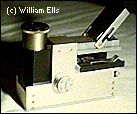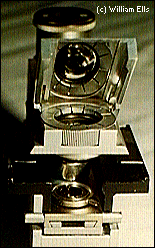MY FAVOURITE MICROSCOPE
(A review of the McArthur Microscope)
Text by Don Bruce, Images by William Ells
 I suppose everyone interested
in microscopy has a favourite microscope, I have always been
attracted to miniaturisation and when it is combined with superb
engineering mine has to be the McArthur microscope. (see
photograph/s) This gem of a portable microscope is solid in
construction all components being mounted in a aluminium block
with a very firm mounting for the slide. The instrument measures
only 4" x 2.5" x 2" (102 x 63 x 51 mm.) yet it is
capable of all that can be accomplished with a bench microscope
of similar optical specification, it will even accept a binocular
head.
I suppose everyone interested
in microscopy has a favourite microscope, I have always been
attracted to miniaturisation and when it is combined with superb
engineering mine has to be the McArthur microscope. (see
photograph/s) This gem of a portable microscope is solid in
construction all components being mounted in a aluminium block
with a very firm mounting for the slide. The instrument measures
only 4" x 2.5" x 2" (102 x 63 x 51 mm.) yet it is
capable of all that can be accomplished with a bench microscope
of similar optical specification, it will even accept a binocular
head.
 To keep within the limits of
the small body Dr.John McArthur designed a folded optical
prismatic system mounted in a detachable tube which approximated
the 160mm. tube length of the standard microscope. This tube
forms the base of the microscope. Light enters the instrument
from above, either by means of the stainless steel mirror or from
a built in electric lamp and passes downwards through the iris
and condenser to the specimen. The objectives are below the
specimen and the light forming image is reflected by the
prismatic system to the eyepiece, the image is the right way up,
not inverted as in a conventional microscope.
To keep within the limits of
the small body Dr.John McArthur designed a folded optical
prismatic system mounted in a detachable tube which approximated
the 160mm. tube length of the standard microscope. This tube
forms the base of the microscope. Light enters the instrument
from above, either by means of the stainless steel mirror or from
a built in electric lamp and passes downwards through the iris
and condenser to the specimen. The objectives are below the
specimen and the light forming image is reflected by the
prismatic system to the eyepiece, the image is the right way up,
not inverted as in a conventional microscope.
The microscope slide on which the specimen is mounted is
placed coverglass down on the stage the upper surface of the
cover glass being level with the upper surface of the stage. Thus
the specimen is always in focus irrespective of the thickness of
the slide. A fine focus control is provided to allow for specimen
thickness, coarse focussing is unnecessary.
The three objectives are optically standard but mechanically
shortened and mounted on a sliding plate, they are
interchangeable, with a comprehensive range of objectives,
including 4:1 and a 100:1 oil immersion, a phase contrast set for
example could be mounted on a spare sliding plate, although I
have only one plate fitted with 10:1, 20:1, & 40:1. dry
objectives. Because the objectives are always in focus the Abbe
condenser is also in permanent focus and likewise
interchangeable. The eyepiece is a RMS size push fit and also
interchangeable, mine is a 10:1.
The latest models are fitted with a tapping in the base which
will accept a camera tripod. A short tripod greatly facilitates
bench use of the microscope. Mine was an earlier model so I have
manufactured a cradle to take the microscope and this can be
fitted to a tripod. The weight of the microscope without its case
is only 18 ounces (510 gms.). The one inconve- nience I have
found is the standard 3" x 1" (76 x 25 mm.) microscope
slide projects over the edges of the stage and can be easily
caught by the fingers when the instrument is hand held and the
objective plate is being manipulated.
The McArthur microscope has been manufactured by several
companies since its inception. Today it is marketed by Prior
Scientific Instruments, London Road, Bishops Stortford, Herts,
CM23 5NB. Tel: 0127 506414. I do not know the current price,
their 1980 price list quotes L407 plus VAT for the standard
outfit for Bright field work, with mirror, Abbe condenser,
Huygenian 10:1 eyepiece, 10:1, 40:1 & 100:1 o.i. objectives,
lamp, simple light tube and vinyl case. At one stage Dr.McArthur
manufactured the instrument himself and it is one from his
production line which I own. I bought it second hand in mint
condition in 1968 from Dr.Raymond Greene, brother of author
Graham Greene, for L30. If you like the McArthur microscope but
do not like its price it is sometimes available on the second
hand market at around 250.00 pounds.
There is a very cheap alternative, and that is the McArthur
microscope designed for the Open University, It employs the same
system as the original microscope but is larger in length &
height 5" x 3" (127 x 76 mm.) but at 1" (25 mm.)
only half the thickness. It is made almost entirely of plastic
with a total weight of 7.5 ounces (198.5 grams). The standard
Open University microscope has a fixed 10:1 eyepiece with a
sliding objective plate with fixed 8:1 & 20:1 objectives. It
has an internal light source or it can be used with an external
lamp or daylight. There is a tripod adapter in the base. The
specimen slide is held longitudinally and is therefore more
easily controlled and is not likely to be moved by the fingers
when handling the instrument.
 The Swift Microscope
The Swift Microscope
I have added a photograph of the Swift Field Microscope which
I also own, it is similar in concept to the MacArthur but not so
compact, for example the mirror and condenser is not built in.
Note the objectives are on revolving holder not in line on a
slider as on the MacArthur.
by Don Bruce 1995
© Microscopy UK or their
contributors.
Please report any Web problems
or offer general comments to the Micscape Editor,
via the contact on current Micscape Index.
Micscape is the on-line monthly
magazine of the Microscopy UK web
site at Microscopy-UK
WIDTH=1
© Onview.net Ltd, Microscopy-UK, and all contributors 1995 onwards. All rights
reserved. Main site is at www.microscopy-uk.org.uk with full mirror at www.microscopy-uk.net.
 I suppose everyone interested
in microscopy has a favourite microscope, I have always been
attracted to miniaturisation and when it is combined with superb
engineering mine has to be the McArthur microscope. (see
photograph/s) This gem of a portable microscope is solid in
construction all components being mounted in a aluminium block
with a very firm mounting for the slide. The instrument measures
only 4" x 2.5" x 2" (102 x 63 x 51 mm.) yet it is
capable of all that can be accomplished with a bench microscope
of similar optical specification, it will even accept a binocular
head.
I suppose everyone interested
in microscopy has a favourite microscope, I have always been
attracted to miniaturisation and when it is combined with superb
engineering mine has to be the McArthur microscope. (see
photograph/s) This gem of a portable microscope is solid in
construction all components being mounted in a aluminium block
with a very firm mounting for the slide. The instrument measures
only 4" x 2.5" x 2" (102 x 63 x 51 mm.) yet it is
capable of all that can be accomplished with a bench microscope
of similar optical specification, it will even accept a binocular
head.  To keep within the limits of
the small body Dr.John McArthur designed a folded optical
prismatic system mounted in a detachable tube which approximated
the 160mm. tube length of the standard microscope. This tube
forms the base of the microscope. Light enters the instrument
from above, either by means of the stainless steel mirror or from
a built in electric lamp and passes downwards through the iris
and condenser to the specimen. The objectives are below the
specimen and the light forming image is reflected by the
prismatic system to the eyepiece, the image is the right way up,
not inverted as in a conventional microscope.
To keep within the limits of
the small body Dr.John McArthur designed a folded optical
prismatic system mounted in a detachable tube which approximated
the 160mm. tube length of the standard microscope. This tube
forms the base of the microscope. Light enters the instrument
from above, either by means of the stainless steel mirror or from
a built in electric lamp and passes downwards through the iris
and condenser to the specimen. The objectives are below the
specimen and the light forming image is reflected by the
prismatic system to the eyepiece, the image is the right way up,
not inverted as in a conventional microscope.  The Swift Microscope
The Swift Microscope